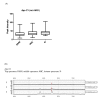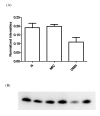Plasma proteome analysis of patients with type 1 diabetes with diabetic nephropathy
- PMID: 20205888
- PMCID: PMC2827395
- DOI: 10.1186/1477-5956-8-4
Plasma proteome analysis of patients with type 1 diabetes with diabetic nephropathy
Abstract
Background: As part of a clinical proteomics program focused on diabetes and its complications we are looking for new and better protein biomarkers for diabetic nephropathy. The search for new and better biomarkers for diabetic nephropathy has, with a few exceptions, previously focused on either hypothesis-driven studies or urinary based investigations. To date only two studies have investigated the proteome of blood in search for new biomarkers, and these studies were conducted in sera from patients with type 2 diabetes. This is the first reported in depth proteomic study where plasma from type 1 diabetic patients was investigated with the goal of finding improved candidate biomarkers to predict diabetic nephropathy. In order to reach lower concentration proteins in plasma a pre-fractionation step, either hexapeptide bead-based libraries or anion exchange chromatography, was performed prior to surface enhanced laser desorption/ionization time-of-flight mass spectrometry analysis.
Results: Proteomic analysis of plasma from a cross-sectional cohort of 123 type 1 diabetic patients previously diagnosed as normoalbuminuric, microalbuminuric or macroalbuminuric, gave rise to 290 peaks clusters of which 16 were selected as the most promising biomarker candidates based on statistical performance, including independent component analysis. Four of the peaks that were discovered have been identified as transthyretin, apolipoprotein A1, apolipoprotein C1 and cystatin C. Several yet unidentified proteins discovered by this novel approach appear to have more potential as biomarkers for diabetic nephropathy.
Conclusion: These results demonstrate the capacity of proteomic analysis of plasma, by confirming the presence of known biomarkers as well as revealing new biomarkers for diabetic nephropathy in plasma in type 1 diabetic patients.
Figures





References
-
- Cameron JS. The discovery of diabetic nephropathy: from small print to centre stage. J Nephrol. 2006. pp. 75–87. - PubMed
LinkOut - more resources
Full Text Sources
Research Materials

